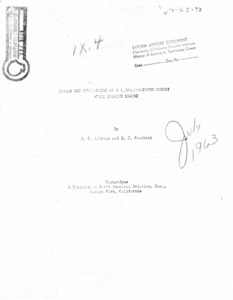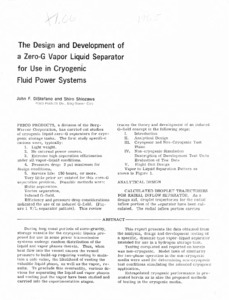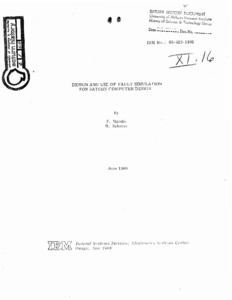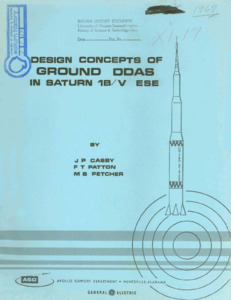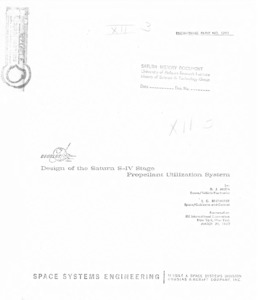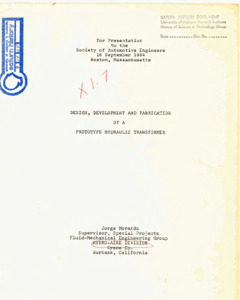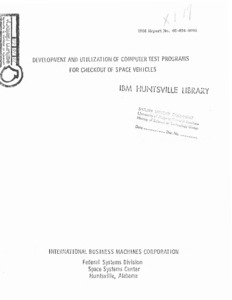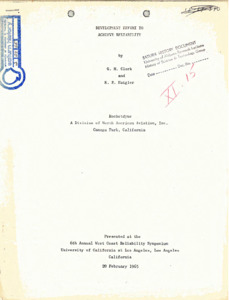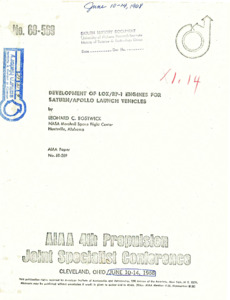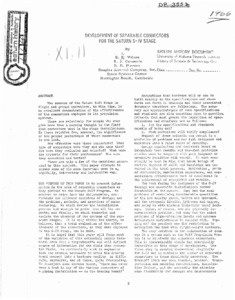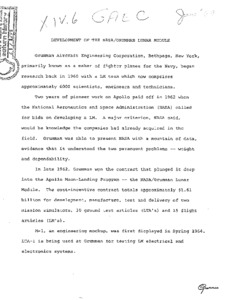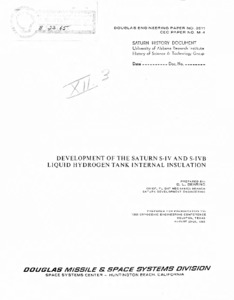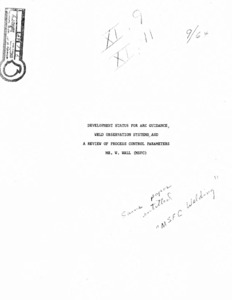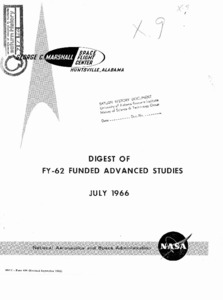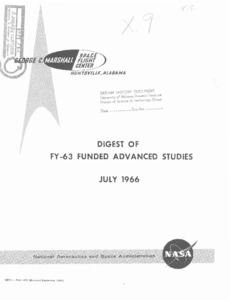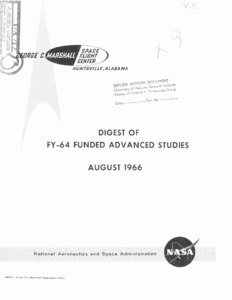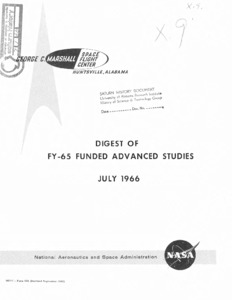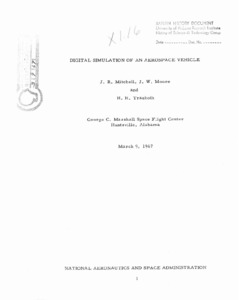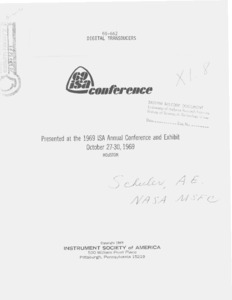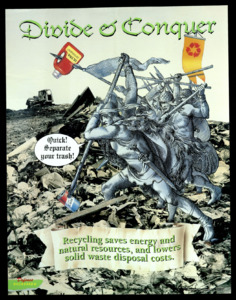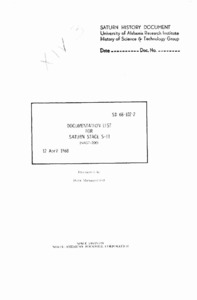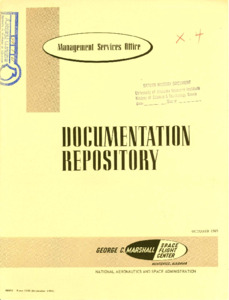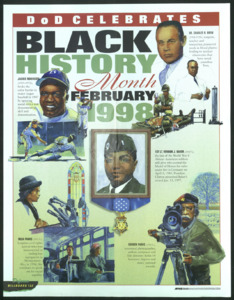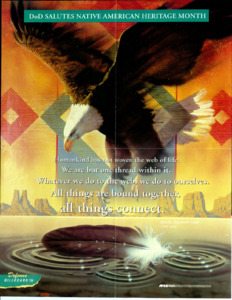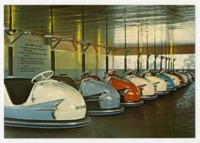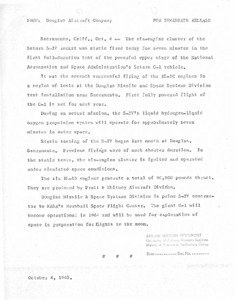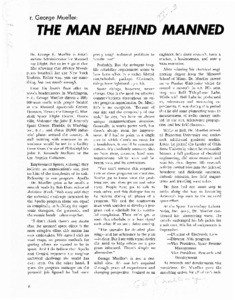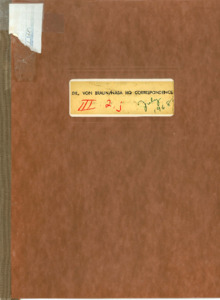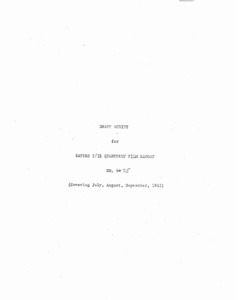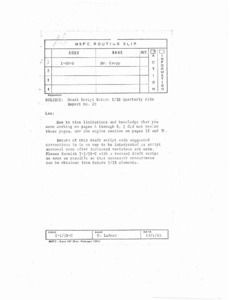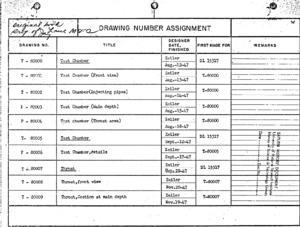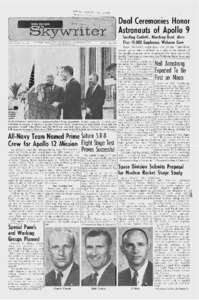
Browse Items (6320 total)
Sort by:
-
"Department of Defense Celebrates; March 1997; Women's History Month"
Various pictures of women in the Armed Forces throughout history -
"Departure fr. Germany, Ffm Airport & Arrival in N.Y. Summer 1960."
Trip to Frankfurt, West Germany. Shows multiple shots of Frankfurt airport as well as taking off and aerial views of Germany. Final shots show touchdown in New York and the reception area inside of a New York airport. "Ffm" is an abbreviation of Frankfurt am Main. 1960. -
"Design and Development of a 1,500,000-Pound-Thrust Space Booster Engine."
Describes the F-1 engine design and components. -
"Design and Development of a Zero-G Vapor Liquid Separator For Use in Cryogenic Fluid Power Systems."
During long coast periods of zero-gravity, storage vessels for the cryogenic liquids proposed for use in some power transmission systems undergo random distribution of the liquid and vapor phases therein. Thus, when heat flow into the vessel causes the vessel pressure to build-up requiring venting to maintain a safe value, the likelihood of venting the valuable liquid phase, as well as the vapor, results. To preclude this eventuality, various devices for separating the liquid and vapor phases and venting just the vapor have been studied and carried into the experimentation stages. -
"Design and Use of Fault Simulation for Saturn Computer Design."
Describes different aspect of the Fault Simulation for Saturn computer design. -
"Design Concepts of Ground DDAS in Saturn 1B/V ESE."
In the Saturn IB/V programs the sheer quantity of data required for computer processing and ESE display makes it necessary to provide an efficient data acquisition system. For much of the data originating in the launcher this requirement is satisfied by the Ground Digital Data Acquisition System (DDAS). This paper provides a technical description of the Ground DDAS with emphasis placed on the unique design concepts of this telemetry system. -
"Design of the Saturn S-IV Stage Propellant Utilization System."
Describes the SIV vehicle and its components. Presented at: IRE International Convention. -
"Design, Development, and Fabrication of a Prototype Hydraulic Transformer."
For presentation to the Society of Automotive Engineers, 16 September 1964, Boston, Massachusetts. ABSTRACT: This paper discusses the design, development and fabrication of a prototype hydraulic transformer, Hydro-Aire Model No. 05-055, performed in fulfillment of the requirements of Contract No. NAS 8-5264 for NASA Marshall Space Flight Center. The Hydraulic Transformer described is designed to pump hydraulic oil at a flow of 100 GPM with a pressure rise of 4000 psi, and does this work by utilizing as a power source the flow of RP-1 rocket fuel at a pressure of 1900 psig. The Hydraulic Transformer built to handle this combination of flows and pressures, unprecedented in such devices, has a weight of only 70 pounds for the first development model. The development of this unit is discussed and future development improvements are mentioned. -
"Development and Utilization of Computer and Test Programs for Checkout of Space Vehicles."
A computer system was designed to allow test engineers to progressively employ automation in the checkout of the Uprated Saturn I and Saturn V space vehicle programs and still allow manual control of the checkout process. A two-computer system was selected by National Aeronautics and Space Administration, and the International Business Machines Corporation was chosen to provide the programming engineering necessary to implement these objectives. Space vehicle checkout, prior to launch, may be characterized by controlling, monitoring, and testing the vehicle and its subsystems through the use of ground support equipment (GSE).; IBM Huntsville Library.; Presented at AIAA Conference, XVIIth International Astronautical Congress, Madrid, Spain, October 10-15, 1966 by Edward A. Robin, Manager, Vehicle Test Programming Department. -
"Development Effort to Achieve Reliability."
Presented at the 6th West Coast Reliability Symposium, University of California at Los Angeles, Los Angeles, California, 20 February 1965.The development of a large liquid rocket engine can represent the expenditure of several hundred million dollars of effort. Before 30 percent of the contracted development funds have been expended, however, the engine will probably have operated for the mission duration. The capability to operate at least one successful test early in a development program is evidence of achieving a minimal reliability level, but the major objective of the development program is producing a design which performs reliably. A rocket engine reliability prediction must view reliability as a dynamic concept, constantly being altered by development effort. -
"Development of LOX-Hydrogen Engines for the Saturn Apollo Launch Vehicles."
During the development of the RL-10 and J-2 engines, many problems were encountered. Solutions to the significant problems are contained. A description of these LOX-Hydrogen engines, outlining the unique features of each will be given. Performance parameters for both engine systems are tabulated. Specific applications to various stages are shown. -
"Development of LOX/RP-1 Engines for Saturn/Apollo Launch Vehicles."
The development of liquid rocket engines follow similar patterns regardless of engine size. During the development of the H-1 and F-1 engines, many problems were encountered. Methods of solving the combustion instability problem are discussed. A description is given of the major components of each engine, outlining their unique features. The requirements for an insulation cocoon are discussed. Problems associated with materials substitution are provided; also highlighted is the fact that problems occur after engine deliveries and require continued development support. Safety features incorporated on the engines are mentioned. Solution to problems encountered in flight are discussed. Upratings of both engines systems are presented graphically.; On the NASA Technical Reports Server (NTRS) unclassified. Can also be found on AIAA. -
"Development of Separable Connectors for the Saturn S-IV Stage."
The purpose of this paper is to present information, in the area of separable connectors as they pertain to the Saturn S-IV Program. -
"Development of the NASA/Grumman Lunar Module."
Paper regarding the actions and achievement of the Grumman Aerospace Corporation. -
"Development of the Saturn S-IV and S-IVB Liquid Hydrogen Tank Internal Insulation."
In April of 1960 the Douglas Aircraft Company was awarded a contract to develop the second and uppermost stage for the Saturn I space booster. In order to realize the high specific impulse available, this stage, called the S-IV, was to utilize liquid hydrogen and liquid oxygen as the propellants. After burn-out of the first stage, the S-IV Stage was to ignite its engines at an altitude of approximately 200,000 feet, burn for approximately 8 minutes, and inject a 20,000 lb spacecraft into a low earth orbit. This program represented Douglas's first major endeavor with liquid hydrogen. It was necessary to develop an insulation for the S-IV Stage that was capable of withstanding the thermal shock associated with loading, could provide adequate insulative properties to limit the flow of heat into the hydrogen, and was of minimum weight. This latter fact cannot be over emphasized because every extra pound of insulation is one less pound of available payload weight. -
"Development Status for Arc Guidance, Weld Observation Systems, and a Review of Process Control Parameters."
Letter to David L. Christiensen from W. A. Wall, enclosing requested documents. -
"Digest of FY-62 Funded Advanced Studies : July 1966."
This publication is one of a planned series to summarize the MSFC advanced study program for each fiscal year beginning with FY-61. A separate report will cover the study program for each fiscal year. The purpose of these documents is to provide historical reference information which should be helpful in planning future study programs. The FY-62 funded studies are covered in this document. These investigations are covered under two major categories: Launch Vehicle Studies; and Lunar, Orbital, and Planetary Studies. The information presented on each study includes a brief description of the objectives and results and pertinent contract data. In order to keep this report small and easy to use, no attempt was made to include conclusions based on the study results ; however,the final reports documenting the investigations are referenced. If these reports are needed for permanent retention and are not available from the MSFC Library (MS-IPL), submit requests for the documents to the Scientific and Technical Information Facility, Attention: NASA Representative, P.0. Box 33, College Park, Maryland 20740. -
"Digest of FY-63 funded advanced studies : July 1966."
This publication is, one of a planned series to summarize the advanced study program for each fiscal year beginning with FY-61. A separate report will cover the study program for each fiscal year. The purpose of these documents is to provide historical reference information which should be helpful in planning future study programs. The FY-63 funded studies are covered in this document. These investigations are covered under three categories: Launch Vehicle and Supporting Studies; Orbital and Lunar Studies; and Planetary Studies. The information presented on each study includes a brief description of the objective and results and pertinent contract data. In order to keep this report small and easy to use, no attempt was made to include conclusions based on the study results; however, the final reports documenting the investigations are referenced. If these reports are needed for permanent retention and are not available from the Technical Supervisor or the MSFC Library (MS-IPL), submit requests for the documents to the Scientific and Technical Information Facility, Attention: NASA Representative, P. O. Box 33, College Park, Maryland 20740. -
"Digest of FY-64 Funded Advanced Studies: August 1966."
This paper outlines the major advantages of digital transducers and describes the principles and features (1) direct digital transducers, (2) indirect digital transducers, (3) quasi-digital transducers, and (4) A to D transducers. The mutual effect of transducers and systems will be discussed briefly, and some trends of transducer research and development will be presented. -
"Digest of FY-65 Funded Advanced Studies:July 1966."
This publication is one of a planned series to summarize the advanced study program for each fiscal year beginning with FY-61.A separate report will cover the study program for each fiscal year. The purpose of these documents is to provide reference information which should be helpful in planning future study programs. The FY-65 funded studies are covered in this document. These investigations are covered under four major headings: Launch Vehicle Studies, Earth Orbital and Lunar Studies, Planetary/Nuclear Studies, and AAP Studies. The information presented on each studyincludes a brief description of the objectives and pertinent contract data. -
"Digest of FY-66 Funded Advanced Studies: November 1966."
This publication is one of a planned series to summarize the advanced study program for each fiscal year beginning with FY-61.A separate report will cover the study program for each fiscal year. The purpose of these documents is to provide reference information which should be helpful in planning future study programs. The FY-65 funded studies are covered in this document. These investigations are covered under four major headings: Launch Vehicle Studies, Earth Orbital and Lunar Studies, Planetary/Nuclear Studies, and AAP Studies. The information presented on each studyincludes a brief description of the objectives and pertinent contract data. -
"Digital Simulation of an Aerospace Vehicle."
The rapid development of computer technology and the creation of new engineering oriented languages has established that general purpose digital computers are now extremely suitable to perform simulation of large scale physical systems. With Aerospace Vehicle Simulation (AVS), an effort has been undertaken at MSFC to simulate continuous and discrete dynamics of an aerospace vehicle and its ground support equipment on a large digital computer. This simulation produces a copy of the physical vehicle configuration and its functions in the form of a large scale mathematical model in the computer. AVS will be an essential part of an integrated information system which can be used by several laboratories and offices at MSFC for the design, checkout, test, and management of aerospace vehicles. -
"Digital Transducers."
This paper outlines the major advantages of digital transducers and describes the principles and features (1) direct digital transducers, (2) indirect digital transducers, (3) quasi-digital transducers, and (4) A to D transducers. -
"Disney World."
Ingeborg and Konrad Dannenberg visit Disney World outside of Orlando, Florida. The film shows them walking around and looking at the sights along main street and up to the castle. Spring 1972. -
"Do you have to get hit over the head to realize it's smart to wear a HELMET?"
Motocycle wreck and getting hit in the head various ways -
"Documentation List for Saturn Stages S-11."
The information presented in this document represents a listing of all formal documentation prepared under contract NAS7-200. The listing has been arranged under major categories as specific in SID 61-366A, reissued 10 August 1964. Within each categorization , the reports and specifications have been listed in numerical sequence. -
"Documentation Repository."
This brochure describes, for the benefit of documentation users, the services and materials that are available from the Documentation Repository. The present operations of the Repository are illustrated to provide a comprehensive picture of work flow, time scheduling and product output. -
"DOD Celebrates Black History Month February 1998, Jackie Robinson, Dr. Charles R. Drew, 1st Lt. Vernon J. Baker, Rosa Parks, Gordan Parks"
Photos of important historical figures of Black History Month with photos to describe their contributions to history and their significance to paving the way in the Civil Rights Movement -
"Dodge City, Kansas, Boot Hill - Niagara Falls."
First portion shows Konrad, Klaus, and Ingeborg stopping in Dodge City, Kansas and touring Boot Hill, Summer 1956. The second portion is Konrad filming Niagara Falls. -
"Dodgem Your Next Ride" advertisement.
This card has an image of the "beautiful Fibreglas Space Age Dodgem car" and a price for it. -
"Douglas Aircraft Company Press release."
Press release covering the static firing of the S-IV rocket for a full seven minutes. -
"Dr. George Mueller: The Man Behind Manned."
G. E. Challenge. Article written about George Mueller, NASA Associate Administrator for Manned Space Flight. -
"Dr. H. Borchers in Schloss 'Bodenwerder' Fähre bei (Heyen) - Hotel Thüringer Hof + Osterstr. / 2nd half unexposed."
Konrad Dannenberg visits a friend of his, Dr. Borchers, in Germany. The doctor is shown tending to his plants and pet dogs in his back yard, as well as Konrad, Dr. Borchers and his wife driving to the city center. Heyen is located north of Bodenwerder, just across the Weser River. -
"Dr. von Braun/NASA HQ correspondence: July 1968."
This contains a two page list of the correspondence which is scanned separately. It includes the date and a brief description of the correspondence. -
"Draft Script for Saturn I/IB Quarterly Film Report No. 25 (Covering July, August, September, 1965)."
Draft script for quarterly report: July through September, 1965. -
"Draft script Saturn I/IB quarterly film report no. 25."
MSFC routing slip to Mr. Lee Cropp concerning the draft copy. Contains hand-written editing suggestions, as well as a note that even if these suggestions are applied, that does not imply approval of the script for use. Covers July, August and September, 1965. -
"Drawing number assignment"
The document is a photocopy of the Drawing Number Assignments from August 1947 to May 1953. Categories include but are not limited to the drawing number, title, designer, and date finished. Inscribed on the front is "original book property of Jay Laue, MSFC." -
"Dual ceremonies honor astronauts of Apollo 9."
A news article detailing the 'welcome back' ceremony for the nine astronauts who had just returned from a 10-day mission.


